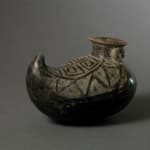Chorrera Terracotta Zoomorphic Vessel with the Head of a Human, 1100 BCE - 300 CE
Terracotta
4.375
PF.2430
Further images
The Pre-Columbian cultures of Ecuador are among the oldest in South America and among the first to master the art of pottery. Although we know little about the peoples themselves...
The Pre-Columbian cultures of Ecuador are among the oldest in South America and among the first to master the art of pottery. Although we know little about the peoples themselves or their traditions, historians have been able to piece together a picture of life in Ancient Ecuador thanks in part to the art and artifacts left behind. The culture of Valdivia created some of the oldest known works of art in the Americas. Situated along the coastal strip of Ecuador, the Valdivians established a thriving society that flourished for around two thousand years (from approximately 4000 to 1500 B.C.). Today they are famed for their small fertility figures, believed to be the earliest representational works of art in the Americas, first carved from stone, later formed from terracotta.
Hundreds of years later after the Valdivians disappear from the archaeological record appears another culture to which the name Chorrera has been attached (lasting from circa 1100-300 B.C.). Little is known about this culture; however, it is significant for its widespread geographical reach. As such, their artistic style greatly influenced those diverse cultures that began to emerge in the final centuries of the Chorrera period, a time historians have labeled the Period of Regional Development.
This composite figure vessel from the Chorrera period, contemporary with the Chavin of Peru and the Tlatilco in Mexico, demonstrates the Ecuadorian craftsmen refined skill at manipulating the medium to create a beautiful and spirited work of ceramic art. We see the body of this delicate black ware vessel sculpted into the shape of a stout bodied bird, its tail feathers gracefully sweeping upward. Geometric decorations on the upper body of the bird highlight its curved shape while delicately carved front wings direct our attention to the neck and spout of the vessel. Here the artist has skillfully molded the face of a human onto the neck of the pot. Slanted eyes gaze out at us while we view his fascinating face, complete with large ornamented nose and ear spool decorations. An everted rim on the vessel tops the human head almost giving the appearance of a hat rim, lowest on the figures head. High spirit and a beautiful sense of balance and harmony in this vessel generate within us a feeling of joy and appreciation we delight in experiencing this work of art while at the same time we applaud the ancient craftsmanship that was involved in creating this imaginative vessel.
Hundreds of years later after the Valdivians disappear from the archaeological record appears another culture to which the name Chorrera has been attached (lasting from circa 1100-300 B.C.). Little is known about this culture; however, it is significant for its widespread geographical reach. As such, their artistic style greatly influenced those diverse cultures that began to emerge in the final centuries of the Chorrera period, a time historians have labeled the Period of Regional Development.
This composite figure vessel from the Chorrera period, contemporary with the Chavin of Peru and the Tlatilco in Mexico, demonstrates the Ecuadorian craftsmen refined skill at manipulating the medium to create a beautiful and spirited work of ceramic art. We see the body of this delicate black ware vessel sculpted into the shape of a stout bodied bird, its tail feathers gracefully sweeping upward. Geometric decorations on the upper body of the bird highlight its curved shape while delicately carved front wings direct our attention to the neck and spout of the vessel. Here the artist has skillfully molded the face of a human onto the neck of the pot. Slanted eyes gaze out at us while we view his fascinating face, complete with large ornamented nose and ear spool decorations. An everted rim on the vessel tops the human head almost giving the appearance of a hat rim, lowest on the figures head. High spirit and a beautiful sense of balance and harmony in this vessel generate within us a feeling of joy and appreciation we delight in experiencing this work of art while at the same time we applaud the ancient craftsmanship that was involved in creating this imaginative vessel.







